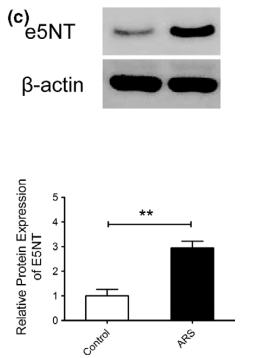NT5E Antibody - #DF6763
| Product: | NT5E Antibody |
| Catalog: | DF6763 |
| Description: | Rabbit polyclonal antibody to NT5E |
| Application: | WB IHC IF/ICC |
| Cited expt.: | WB, IF/ICC |
| Reactivity: | Human, Mouse, Rat |
| Prediction: | Pig, Zebrafish, Bovine, Horse, Sheep, Rabbit, Dog, Chicken, Xenopus |
| Mol.Wt.: | 63kDa; 63kD(Calculated). |
| Uniprot: | P21589 |
| RRID: | AB_2838725 |
Related Downloads
Protocols
Product Info
*The optimal dilutions should be determined by the end user. For optimal experimental results, antibody reuse is not recommended.
*Tips:
WB: For western blot detection of denatured protein samples. IHC: For immunohistochemical detection of paraffin sections (IHC-p) or frozen sections (IHC-f) of tissue samples. IF/ICC: For immunofluorescence detection of cell samples. ELISA(peptide): For ELISA detection of antigenic peptide.
Cite Format: Affinity Biosciences Cat# DF6763, RRID:AB_2838725.
Fold/Unfold
5' NT; 5' nucleotidase (CD73); 5' nucleotidase precursor; 5' nucleotidase, ecto; 5' nucleotidase, ecto (CD73); 5'-NT; 5'-nucleotidase; 5NTD_HUMAN; CD73; CD73 antigen; E5NT; Ecto 5' nucleotidase; Ecto-5'-nucleotidase; eN; eNT; NT; NT5; NT5E; NTE; Purine 5 Prime Nucleotidase;
Immunogens
A synthesized peptide derived from human NT5E, corresponding to a region within N-terminal amino acids.
- P21589 5NTD_HUMAN:
- Protein BLAST With
- NCBI/
- ExPASy/
- Uniprot
MCPRAARAPATLLLALGAVLWPAAGAWELTILHTNDVHSRLEQTSEDSSKCVNASRCMGGVARLFTKVQQIRRAEPNVLLLDAGDQYQGTIWFTVYKGAEVAHFMNALRYDAMALGNHEFDNGVEGLIEPLLKEAKFPILSANIKAKGPLASQISGLYLPYKVLPVGDEVVGIVGYTSKETPFLSNPGTNLVFEDEITALQPEVDKLKTLNVNKIIALGHSGFEMDKLIAQKVRGVDVVVGGHSNTFLYTGNPPSKEVPAGKYPFIVTSDDGRKVPVVQAYAFGKYLGYLKIEFDERGNVISSHGNPILLNSSIPEDPSIKADINKWRIKLDNYSTQELGKTIVYLDGSSQSCRFRECNMGNLICDAMINNNLRHTDEMFWNHVSMCILNGGGIRSPIDERNNGTITWENLAAVLPFGGTFDLVQLKGSTLKKAFEHSVHRYGQSTGEFLQVGGIHVVYDLSRKPGDRVVKLDVLCTKCRVPSYDPLKMDEVYKVILPNFLANGGDGFQMIKDELLRHDSGDQDINVVSTYISKMKVIYPAVEGRIKFSTGSHCHGSFSLIFLSLWAVIFVLYQ
Predictions
Score>80(red) has high confidence and is suggested to be used for WB detection. *The prediction model is mainly based on the alignment of immunogen sequences, the results are for reference only, not as the basis of quality assurance.
High(score>80) Medium(80>score>50) Low(score<50) No confidence
Research Backgrounds
Hydrolyzes extracellular nucleotides into membrane permeable nucleosides. Exhibits AMP-, NAD-, and NMN-nucleosidase activities.
Cell membrane>Lipid-anchor.
Belongs to the 5'-nucleotidase family.
Research Fields
· Metabolism > Nucleotide metabolism > Purine metabolism.
· Metabolism > Nucleotide metabolism > Pyrimidine metabolism.
· Metabolism > Metabolism of cofactors and vitamins > Nicotinate and nicotinamide metabolism.
· Metabolism > Global and overview maps > Metabolic pathways.
References
Application: IF/ICC Species: canine Sample: cDPSCs
Application: IF/ICC Species: beagles Sample: cDPSCs
Application: WB Species: mouse Sample: hippocampus
Restrictive clause
Affinity Biosciences tests all products strictly. Citations are provided as a resource for additional applications that have not been validated by Affinity Biosciences. Please choose the appropriate format for each application and consult Materials and Methods sections for additional details about the use of any product in these publications.
For Research Use Only.
Not for use in diagnostic or therapeutic procedures. Not for resale. Not for distribution without written consent. Affinity Biosciences will not be held responsible for patent infringement or other violations that may occur with the use of our products. Affinity Biosciences, Affinity Biosciences Logo and all other trademarks are the property of Affinity Biosciences LTD.











